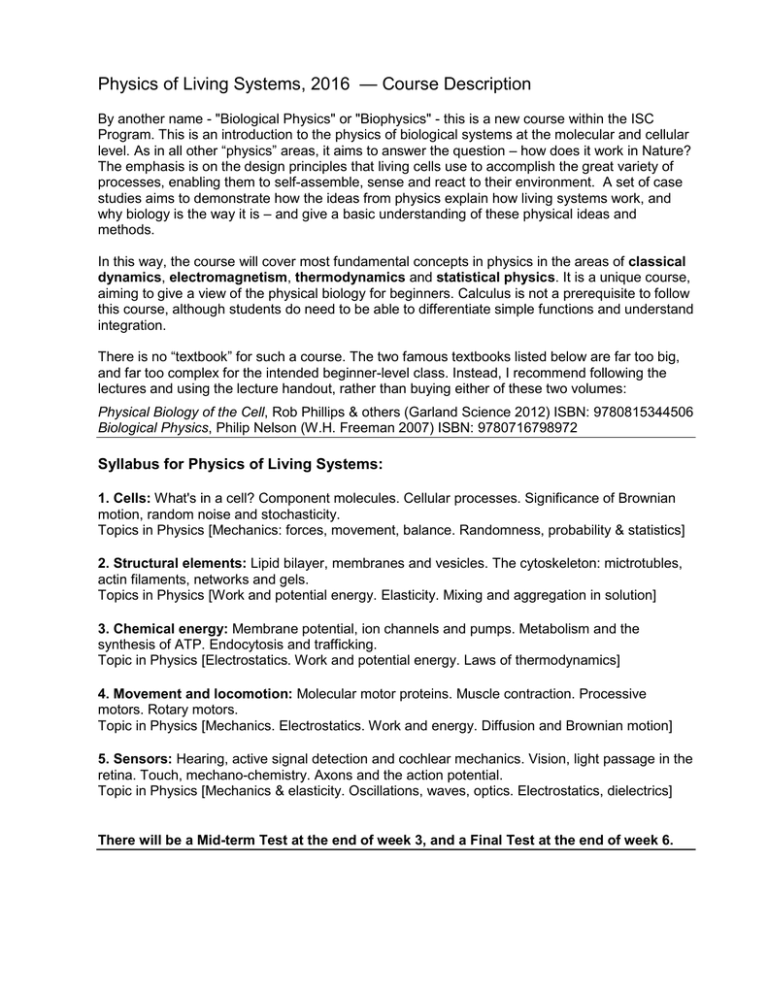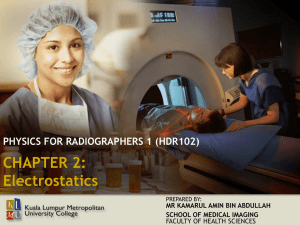Introductory Physics—Course Description:
advertisement

Physics of Living Systems, 2016 — Course Description By another name - "Biological Physics" or "Biophysics" - this is a new course within the ISC Program. This is an introduction to the physics of biological systems at the molecular and cellular level. As in all other “physics” areas, it aims to answer the question – how does it work in Nature? The emphasis is on the design principles that living cells use to accomplish the great variety of processes, enabling them to self-assemble, sense and react to their environment. A set of case studies aims to demonstrate how the ideas from physics explain how living systems work, and why biology is the way it is – and give a basic understanding of these physical ideas and methods. In this way, the course will cover most fundamental concepts in physics in the areas of classical dynamics, electromagnetism, thermodynamics and statistical physics. It is a unique course, aiming to give a view of the physical biology for beginners. Calculus is not a prerequisite to follow this course, although students do need to be able to differentiate simple functions and understand integration. There is no “textbook” for such a course. The two famous textbooks listed below are far too big, and far too complex for the intended beginner-level class. Instead, I recommend following the lectures and using the lecture handout, rather than buying either of these two volumes: Physical Biology of the Cell, Rob Phillips & others (Garland Science 2012) ISBN: 9780815344506 Biological Physics, Philip Nelson (W.H. Freeman 2007) ISBN: 9780716798972 Syllabus for Physics of Living Systems: 1. Cells: What's in a cell? Component molecules. Cellular processes. Significance of Brownian motion, random noise and stochasticity. Topics in Physics [Mechanics: forces, movement, balance. Randomness, probability & statistics] 2. Structural elements: Lipid bilayer, membranes and vesicles. The cytoskeleton: mictrotubles, actin filaments, networks and gels. Topics in Physics [Work and potential energy. Elasticity. Mixing and aggregation in solution] 3. Chemical energy: Membrane potential, ion channels and pumps. Metabolism and the synthesis of ATP. Endocytosis and trafficking. Topic in Physics [Electrostatics. Work and potential energy. Laws of thermodynamics] 4. Movement and locomotion: Molecular motor proteins. Muscle contraction. Processive motors. Rotary motors. Topic in Physics [Mechanics. Electrostatics. Work and energy. Diffusion and Brownian motion] 5. Sensors: Hearing, active signal detection and cochlear mechanics. Vision, light passage in the retina. Touch, mechano-chemistry. Axons and the action potential. Topic in Physics [Mechanics & elasticity. Oscillations, waves, optics. Electrostatics, dielectrics] There will be a Mid-term Test at the end of week 3, and a Final Test at the end of week 6.


